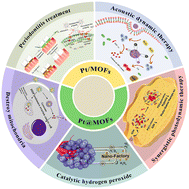Current status and prospects of MOFs in controlled delivery of Pt anticancer drugs
Abstract
Cancer has become the second leading reason for death in the world. Still, cancer therapy development is exceptionally challenging because the tumor microenvironment is very complex, and individual tumors are very different. In recent years, researchers have found that platinum-based drugs in the form of metal complexes can effectively solve tumor resistance. In this regard, metal–organic frameworks (MOFs) as suitable carriers with high porosity are also exceptional in the biomedical field. Therefore, this article reviews the application of platinum as an anticancer drug and the composite anticancer properties of platinum and MOF materials and prospects for its future development, which provides a new direction for further research in the biomedical field.

- This article is part of the themed collection: 2023 Frontier and Perspective articles


 Please wait while we load your content...
Please wait while we load your content...